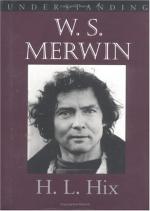|
This section contains 7,583 words (approx. 26 pages at 300 words per page) |

|
SOURCE: Hoeppner, Edward Haworth. “A Nest of Bones: Transcendence, Topology, and the Theory of the Word in W. S. Merwin's Poetry.” Modern Language Quarterly 49, no. 3 (September 1988): 262-84.
In the following essay, Hoeppner discusses Merwin's enigmatic style and the problems it creates for readers and critics alike. Hoeppner attributes this opaqueness to Merwin's use of object images to evoke “interiors” and his phenomenological assertion that “everything has its story.”
But poetry that thinks is in truth the topology of Being.
This topology tells Being the whereabouts of its actual presence.
—Martin Heidegger1
Since the publication of The Moving Target (1963), “absence” has become the shibboleth for critical approaches to W. S. Merwin's poetry. With its variants—viocelessness, silence, abstraction, distance, stasis, apartness, emptiness—it has been used to open discussions of Merwin's sense of self, history, politics, time, and reality, and it has admitted analysis to formal practice, to the...
|
This section contains 7,583 words (approx. 26 pages at 300 words per page) |

|


